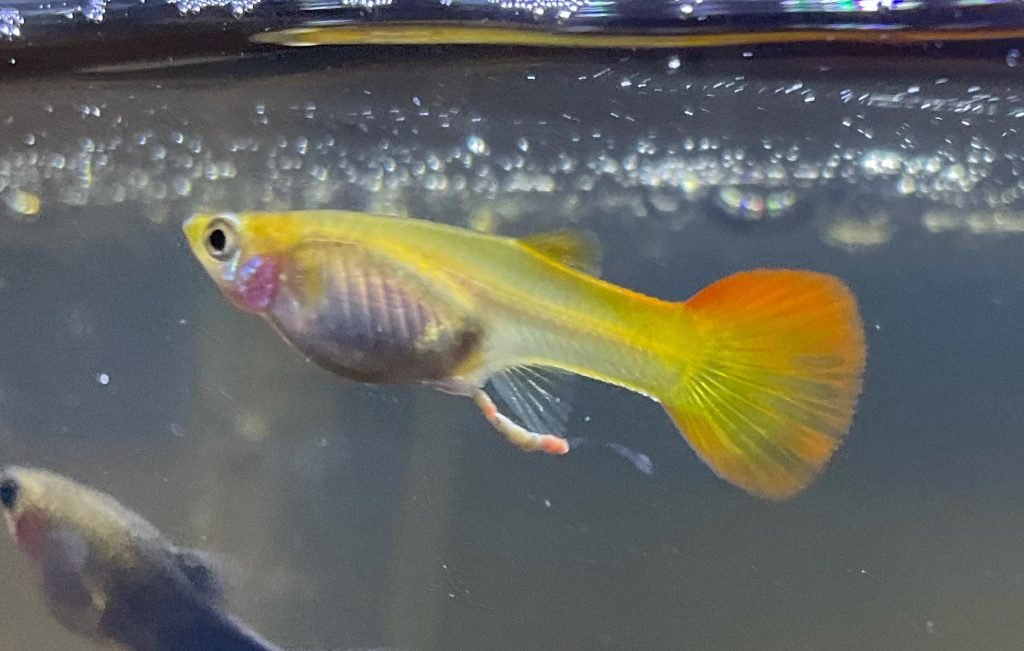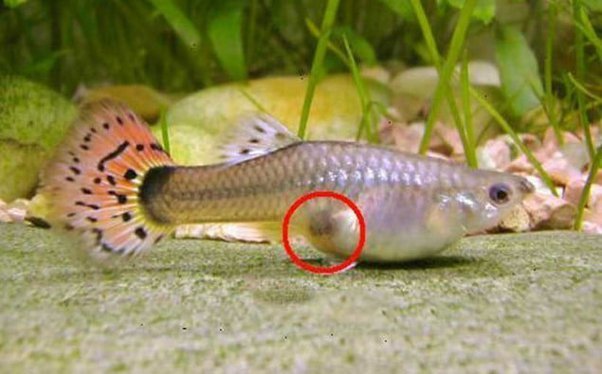How To Breed Guppy Fish
- How to breed guppy fish
- The guppy breeding cycle
- How to breed guppies faster
- How to breed guppies for color
- How to breed guppies in a community tank

The Guppy Breeding Cycle
Overview
The guppy breeding cycle is one that happens pretty quickly. From courtship to birth, the whole process takes about 20-30 days.
Let’s take a quick look at what you are looking at when breeding guppies.
Courtship and Mating
The guppy breeding cycle begins with courtship, where male guppies display their best colors and fins to attract females.
You can expect your male to behave like a peacock at this point.
He will perform elaborate dances to impress the females, and if successful, they will position themselves alongside him.
But the females won’t throw themselves on him.
What will happen more often than not is that the female will just try to live her life as if it never happened.
Which isn’t necessarily a good thing.
Guppies are known the pursue females pretty aggressively. This is the main reason it’s important to keep a ratio of 1 male for every 2-3 females.
Side Note
In order for females to feel safe (and reduce stress, their #1 killer) it’s important that the tank has plenty of hiding spots.
When it comes to how to breed guppy fish- you’ll need to have plenty of hiding space. Those will be vital during the pregnancy stage.
Once the female is ready she’ll position herself near the male and they’ll mate.
Pregnancy and Gestation
Once successfully mated, female guppies undergo a period of gestation, also known as pregnancy.
Unlike livebearers like mammals, female guppies do not have a placenta. Instead, they retain the developing embryos within their bodies and provide nutrients through a yolk sac.
And if you are just as confused reading those 3 lines as I was when I was researching the correct terms then here’s a picture of a pregnant guppy.

How To Tell Your Guppy Is Pregnant
Darkened Gravid Spot
At the end of the stomach, you’ll be able to see a darker gravid spot.
Throughout her pregnancy, that spot could change colors from day to day.
She's less active
Lorem ipsum dolor sit amet, consectetur adipiscing elit. Ut elit tellus, luctus nec ullamcorper mattis, pulvinar dapibus leo.
Her tummy gets big
Lorem ipsum dolor sit amet, consectetur adipiscing elit. Ut elit tellus, luctus nec ullamcorper mattis, pulvinar dapibus leo.
How Long is A Guppy Pregnancy?
The pregnancy usually lasts about 20 to 30 days.
The total length of the pregnancy will vary based on the female’s health, water conditions, and water temperature.
The female’s health is almost directly related to hiding spaces. She knows she’s more vulnerable during her gestation period so she’ll naturally try to avoid the other fish.
Encourage Your Guppy To Give Birth
How To Breed Guppy Fish Pro Hack
I’ve mentioned before how a female guppy won’t drop hey fry until she feels the water is right.
In addition to keeping the water slightly warmer, you also need to make it extremely clean.
If you’re not already performing large water changes on a weekly basis, you need to build up to that.
And as a reminder, keep your water slightly warmer than usual.
Another Pro Tip
Add a teaspoon of aquarium salt for every 5 gallons of water to help alleviate pregnancy stress and encourage your guppy to drop.
Giving Birth
As the pregnancy nears its end, the female’s abdomen becomes visibly larger, resembling a “gravid spot.”

This spot darkens as the embryos develop. When the time is right, the female releases fully formed, miniature versions of her offspring, commonly known as fry.
Do Guppies Lay Eggs?
Nope.
Guppies are livebearers, meaning they give birth to live, free-swimming fry rather than laying eggs.
When breeding guppies, this process should happen in a separate breeding tank or a breeding box. That helps guarantee the fry won’t get eaten by the adults.
Guppy Fish Breeding Temperature
How To Breed Guppy Fish Tips And Tricks
Set the water temperature in your tank to slightly warmer than usual.
In a perfect world, you were keeping your pregnant guppy at waters between 78-82.
The exact temp you set it doesn’t matter as much as it is warmer than the previous temperature.
A female will not drop (give birth) unless she feels the water is ideal for the fry to survive.
Caring for the Fry
We’ve already mentioned it’s important to set up a safe environment for the fry- whether in the form of a breeding tank or a breeding box.
While you care for the fry, make sure you feed them about 5-6 times a day.
I know it’s annoying.
They need to be fed in 2 to 2.5-hour increments a diet consisting of live food and vegetables.
You can use crushed fish pellets as part of their diet- as long as they are able to get their mouth around it.
Growth and Development
Guppy fry will develop pretty quickly- they’ll become juveniles in about 4 weeks and turn into sub-adults in about 8.
At the 2 months mark they will become sexually active. This is good news if you are using them as feeders, and not so good news if you are breeding them as pets.
During this time guppies will be highly susceptible to disease and illness- so it’s important to keep the water parameters within range.
Guppy Fish Breeding Age
Guppies can start breeding at around 8 weeks old.
Repeating the Cycle
You plan for the guppies will dictate what your next step is.
Feeder guppies are free to replicate and mate again- as long as the tank they live in allows it.
Fancy guppies will need to be separated at the 8 weeks mark so they can use the energy they have to continue growing and not for mating.
Feeder Guppies VS. Fancy Guppies
How to care for your guppies will depend on what are you planning on doing with them once fully grown.
Feeder guppies are closer in shape and size and have colors that are more consistent with the colors they are born with in the wild.
The reason for that being that those guppies are used to be fed to larger fish, like piranhas, bluegills, or catfish.
Fancy guppies are bred for entertainment purposes- the main goal is to make them bigger and with more vibrant, unique colors.
How To Breed Guppies Faster
Now that you know what the cycle looks like, let’s shift our focus on how to grow your guppies.
Breed Tank VS Breeding Box
Breed Tank
A breeding tank is a separate aquarium that will be used as a safe space for your pregnant guppy to give birth.
This tank has to be set up just like your main tank- with a big focus on hiding spaces.
Ideally you’d use a seasoned filter with your pump as it will help your water stay within the right levels and save you the time it’ll take to do water changes.
Breeding Box
A breeding box achieves the same result as a breeding tank, but does not require an additional tank.
Instead, it is a a mesh box that you place inside your main tank for your fry to be born in.
It keeps the fry in the main tank, but protects them via the mesh from the adult.
Water Parameters
Water conditions are key when it comes to guppy development. For your guppies to develop to their full potential, you need to maintain consistent water levels.
Toxin Levels
Truth be told, this part is probably the most time consuming when it comes to breeding guppies.
Keep your ammonia and nitrite levels at 0 ppm, and nitrate at up to 20 ppm. pH should be between 6.8-7.8.
Because of you need to feed your guppies about 5 times a day, your water quality will deteriorate quickly.
That means you’d need to change it about every other day or even every day. You only need to do so for the first 4 weeks, though.
When you do change your water make sure its conditioned and temp-matched to avoid shocking your fry.
Water Temp& Lights
The ideal water temperature is around 78-82°F (25-28°C), and it needs to be constant.
That means that fluctuating water temperature will not help your guppies grow bigger or fast- so invest a good water heater to give you the best yield.
Guppy fry should get about 12-18 hours of light a day.
The easiest way to achieve that is with a florenscent light- as you are able to control the amount of light they get.
Don’t place your tank near a window- the sunlight will create big shifts in the water temps which will stress out your fish.
Selecting Breeding Stock
Choose healthy and sexually mature guppies for breeding. Females should have a well-developed gravid spot (a dark spot near the anal fin) indicating their readiness to breed.
Opt for guppies with desirable traits like vibrant colors, unique patterns, or long fins to enhance the quality of the offspring.
Introducing Male and Female Guppies
Introduce one or two male guppies to the breeding tank. Unlike betta fish who need to have a barrier between them as they are introduced, guppies will be ok without it.
Add two or three females for each male to prevent excessive harassment. Remember, males become very persistent with females. They can easily overwhelm them almost to the point of death.
Monitor the interactions between males and females to ensure mating occurs without significant stress or aggression.
This interaction will happen in your main tank, not in the breeding tank/box.
I’ve said it before and I’ll say it again- make sure there are places for your female guppy to hide.
If the male is unsuccessful he will move on to the next female.
Allowing for Natural Mating
The male guppy will use his specialized anal fin, called the gonopodium, to inseminate the female during mating.
Once pregnant, the female will carry the fertilized eggs internally and give birth to live fry in approximately 4-6 weeks, although it can happen in as early as 20 days.
During this time your female guppy will spend more time by herself hiding in the vegetation. She’ll conserve energy ahead of her expected delivery.
You’ll know she is approaching her due date as you’ll be able to see the fry developing in her abdomen.
Caring for the Fry
As we’ve mentioned before- separate the adult guppies from the fry once the female gives birth to prevent them from being eaten.
Then provide appropriate nutrition for the fry, such as finely crushed flake food or specialized fry food. Offer small amounts 4-6 times a day to ensure they receive adequate nutrition.
Keep the water parameters stable, change water very frequently and make sure the water temperature stay consistent.
And lastly, ensure the fry have hiding places like live plants or dense floating plants to help them feel secure.
Growing Fry to Adulthood
As the fry grow, gradually introduce larger food options such as microworms or larger size tropical fish food.
At about 4 weeks old they’ll exist their fry stage and become juveniles. While their care gets less intensive, you’ll still need to keep their water up to par. But at this stage you can start changing their water about twice a week.
Around the one month-old stage is when you’ll be to sex your guppies and 4 weeks after you’ll need to either separate them, or keep breeding.
Conclusion
We’ve covered quite a bit in here- so let’s run a quick recap:
You can plan on a new batch of guppy fry every 30 days. (by the way, they’ll be ready to breed in about 8 weeks. you can read more about it in our guppy fry stage guide.)
The key points to follow when your guppy is pregnant are to provide her with plenty of hiding spots and continue feeding her a good diet.
Now that you have that under your belt- let me ask you a question:
Are you hoping to breed guppies for fun or for profit? Let me know in the comments!
